This news digest is continuously updated with all of our latest news coverage and new products. It’s your one-stop for news at All3DP. Check back every week.
Infinite Promises Faster Water-Soluble 3D Print Supports Than PVA
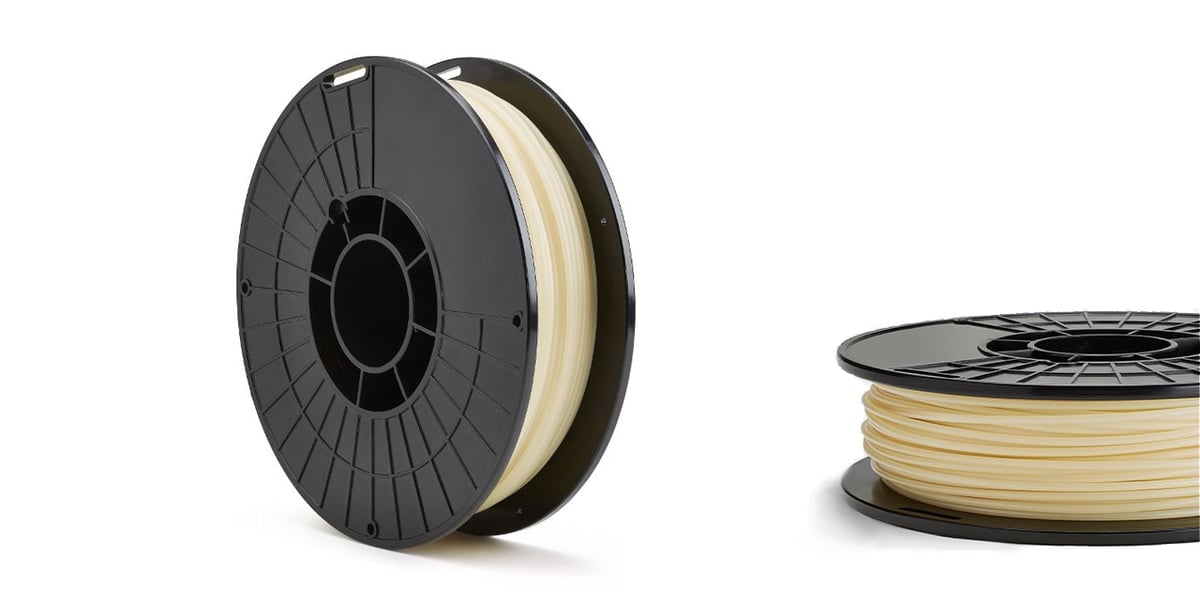
A new PVA alternative from US-based Infinite Material Solutions is designed to bring water-soluble supports a step further. “The market desires support materials that are tap water-soluble, adhere to a wide range of build materials, are eco-friendly, and function with a wide variety of printing platforms,” the company says.
AquaSys GP (general purpose) can be dissolved in room-temperature tap water without any chemicals faster than PVA, according to Infinite. In disolve-rate trials of identically printed parts, AquaSys GP dissolved approximately 20% faster than PVA at room temperature. AquaSys GP generally dissolved at a rate of 13 mg/min, while PVA dissolves at a rate of 11.2 mg/min, the study found.
AquaSys GP is non-toxic, non-carcinogenic, and drain safe, so the tap water and dissolved supports don’t need special disposal handling. The material will biodegrade by at least 80% in freshwater systems within a 6-week window, the company reports.
Infinite won’t say exactly what AquaSys GP is made of except that it’s a composite material that is based “on a naturally occurring carbohydrate that is very rapidly mineralized in the environment.”
AquaSys GP is the company’s entry-level support material. Infinite also makes two engineering-grade support materials: AquaSys 120 is stable in chamber temperatures up to 120ºC, AquaSys 180 is compatible with PEEK, PEKK, PEI, and PPSU.
AquaSys GP Tech Specs
- Size: 1.75 mm, 2.85 mm filament
- Price: $70
- Volume: 500 g
- Extruder temperature: 225ºC – 255ºC
- Build plate temperature: 40ºC – 60ºC
- Chamber temperature: up to 30ºC
- Build Plate Requirements: Glass, PEI
Fleet of 3D Printed Satellites Set to Expand Global Connectivity
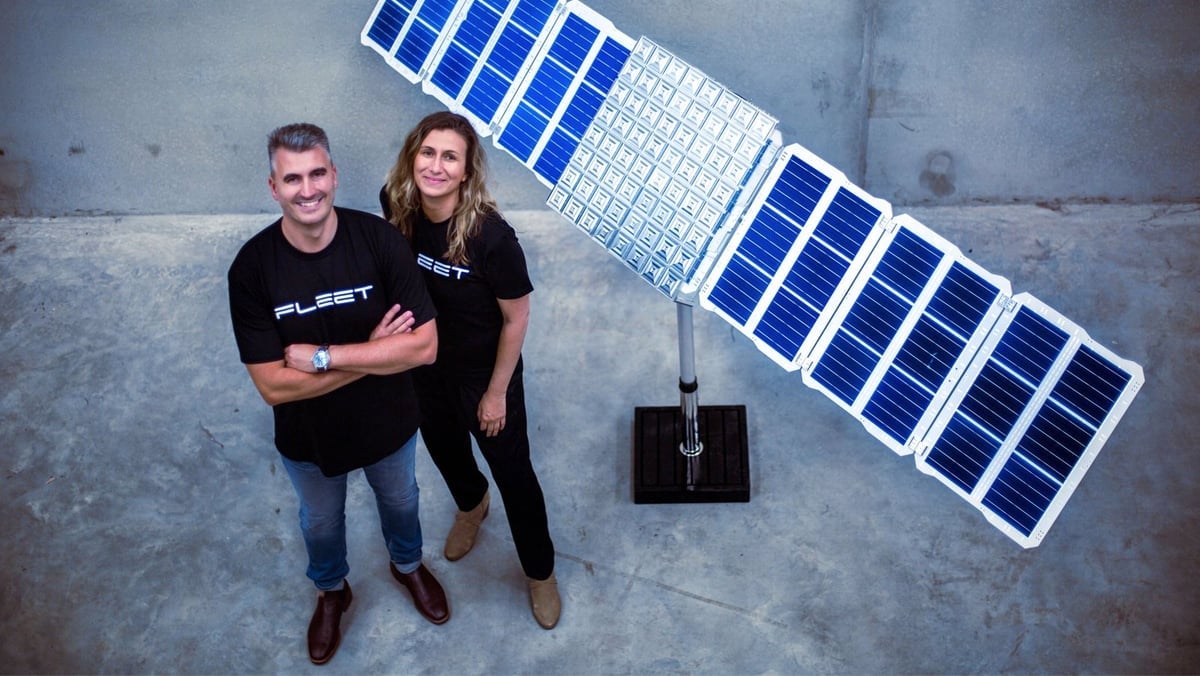
Internet connectivity in remote locations depends on satellites rather than Earth-based service networks to provide wireless communication and data transfer. Coverage isn’t everywhere and where it exists it can be prohibitively expensive, used mainly by the military and industry.
One space company, Fleet Space Technologies, has developed satellites so small, powerful, and affordable that worldwide internet connection via satellite may soon be a reality.
The Australia-based start-up plans to connect billions of devices using constellations of low-earth-orbit nanosatellites equipped with sophisticated communication technology. “It is Fleet Space’s vision that everyone, everywhere, has access to unlimited connectivity, no matter where they are on the globe, in cities, remote regions, on land, or navigating the oceans,” the company says.
The reason these satellites are so groundbreaking has everything to do with 3D printing.
In December, Fleet Space announced that they were developing a new constellation of satellites named Alpha, which will work in harmony with their existing Centauri constellation already in orbit. Alpha represents a major step forward in satellite technology, the company says, and the first time a satellite has been created entirely through 3D printing.
AM Ventures Set to Fund More Entrepreneurs Transforming the World with 3D Printing
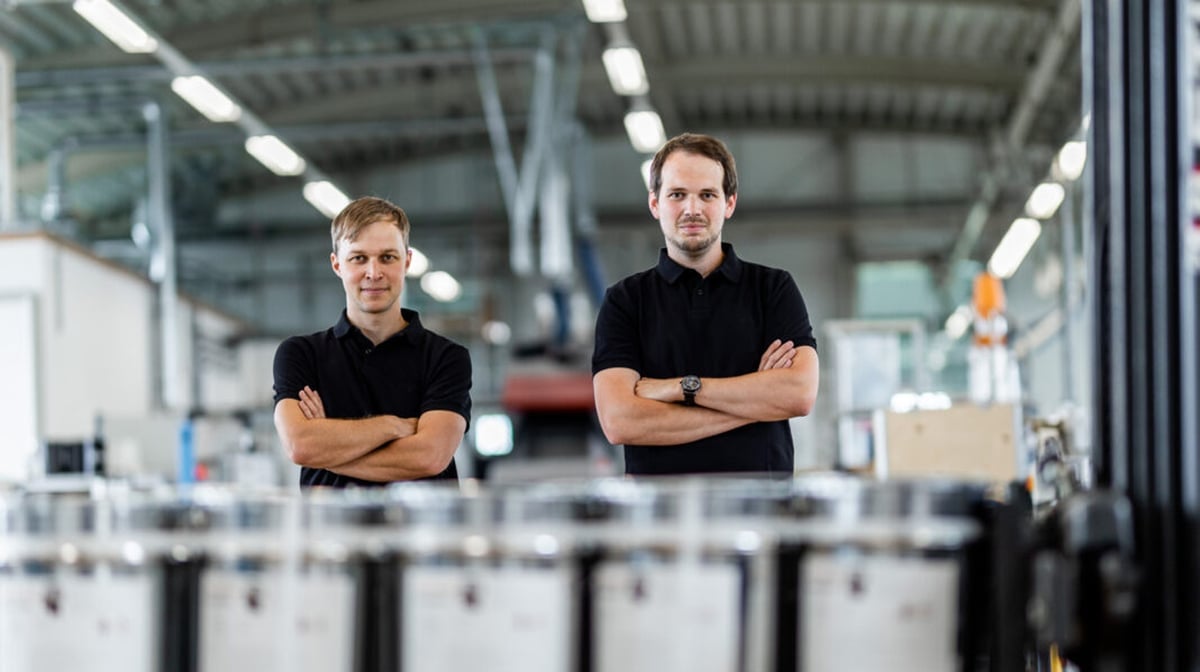
It’s been years in the making. Thousands of start-up 3D printing companies were researched and evaluated for potential funding. Millions of Euros were gathered from global investors eager to participate. Finally today, at €100 million, AM Ventures’ additive manufacturing venture capital fund reached its monetary goal.
Now, AM Ventures will focus on fostering more growth from its portfolio of start-ups and scouting the next success story in 3D printing.
Reaching a goal of €100 million ($102 million) is not only a milestone for the Munich-based venture capital firm, which grew from a private firm of the Langer family, owners of 3D printer maker EOS, to a multi-LP venture capital firm. It represents a validation, the company says, of its mission to lead a sustainable additive revolution fueled by start-ups.
Besides multi-million investments from well-established family offices, asset managers, SMEs, and multinational corporations, the start-up founders who have already been supported by AM Ventures are also among the investors. Although the AM Ventures fund, which opened to investors in March 2021, is the first of its kind dedicated exclusively to additive manufacturing, global capital investment in 3D printing has surged.
Formlabs’ New Printer Delivers Parts Twice as Fast
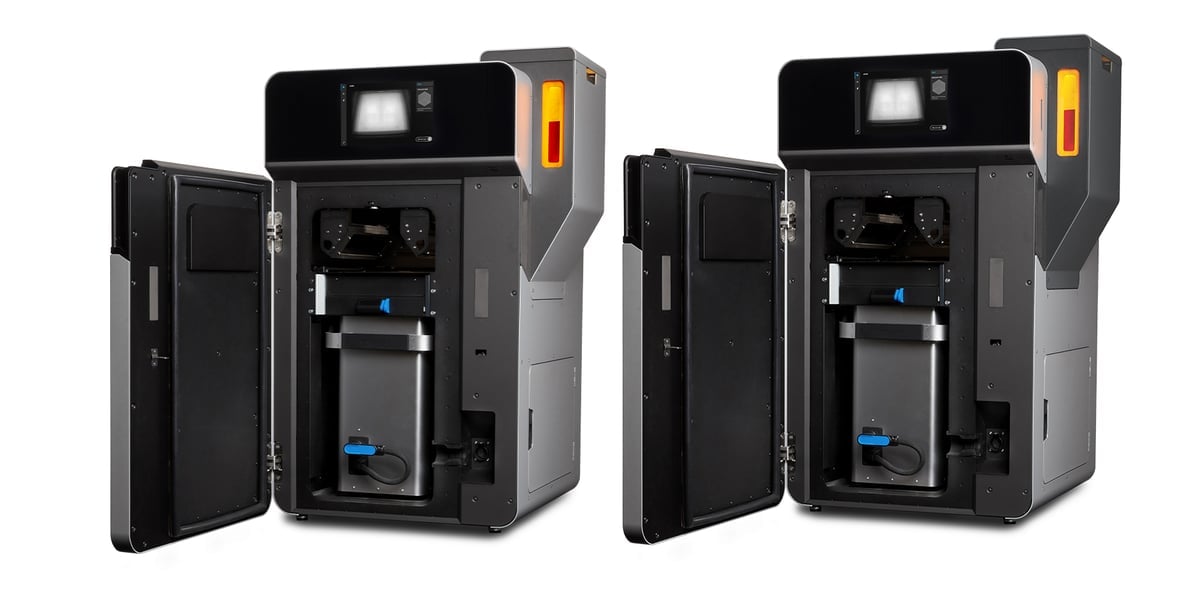
Formlabs, best known for its range of versatile and dependable resin printers, just launched a new version of its selective laser sintering (SLS) 3D printer that can make professional-grade parts from polymer powders twice as fast as its previous version. The Fuse 1+ 30W is a reengineered version of the Fuse 1 that Formlabs introduced in January 2021 to put SLS technology within reach of more small and mid-size businesses. The new upgrades don’t make every print situation twice as fast, but tripling the power of the laser, upgrading the material handling mechanisms, and boosting the ability to tightly pack parts into a single print job, will boost your overall productivity, Formlabs promises.
At a fraction of the cost of most SLS machines on the market, the Fuse 1 quickly became a favorite of small manufacturers, automakers, and shop floors of all varieties for its ability to produce lightweight rigid Nylon parts strong enough to withstand repeated impact, making it ideal for replacement and spare alternatives to metal parts, high-impact equipment, factory tools, and functional prototypes.
EOS Launches NickelAlloy in Bid for Aerospace Part Market

Germany-based metal 3D printer manufacturer EOS this week debuted a new powder material, NickelAlloy Haynes 282, which is a precipitation strengthened nickel-base superalloy with a combination of high-temperature, strength, thermal stability, and manufacturability.
Haynes 282 alloy, a powder intended for manufacturing parts on EOS metal systems with EOS SLM processes, was developed for structural applications and manufactured under license from Haynes International Inc. With this new material, EOS customers can print parts with excellent strength at high temperature and good corrosion and oxidation resistance, specifically aerospace and rocket engine components or energy industry components.
In as-built condition, EOS NickelAlloy Haynes 282 has low strength and high ductility, solution and aging heat treatments are required to produce the microstructure and strengthening phases for high temperature performance.
France Set to Open Europe’s Largest 3D Printed Artificial Marine Reef
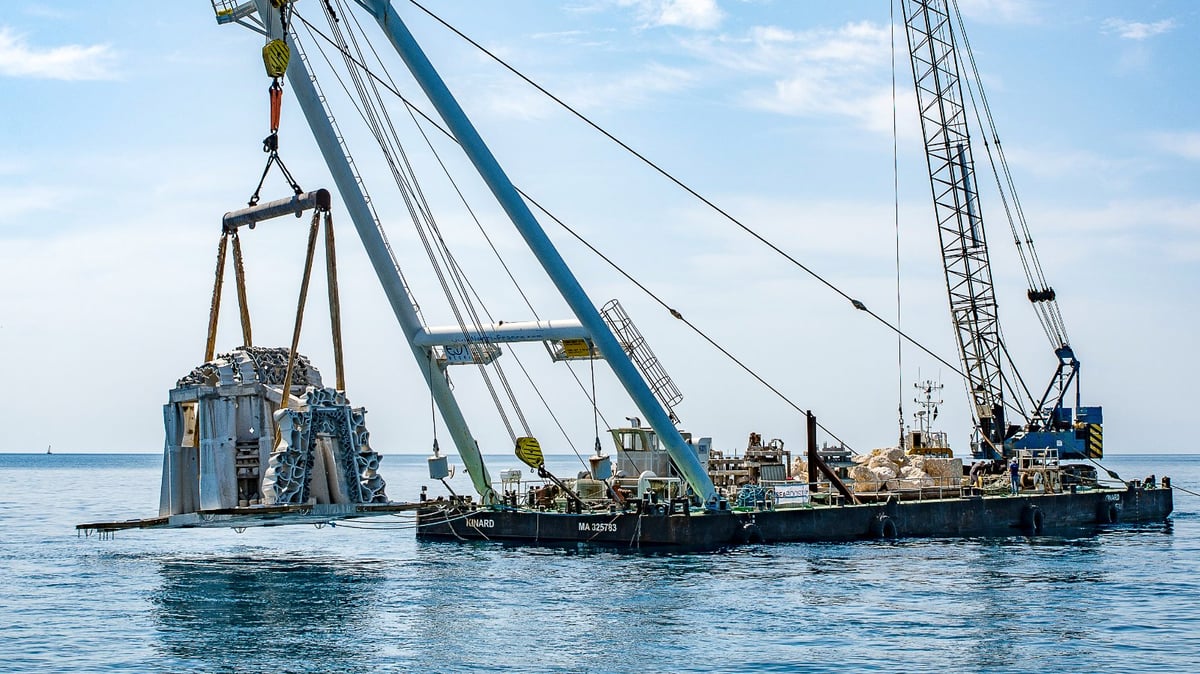
Years in the making, the final pieces of an impressive 3D printed artificial reef were installed this week near a protected marine area in the Mediterranean off the coast of France. Intended as destination for scuba divers, the Mega Reef artificial reef project features small tower modules, clusters, and hangings on a 50-meter linear site, which makes it the biggest European artificial reef 3D printed in concrete.
Scuba tourism is big business globally and growing, but pollution, over fishing, and global warming has decimated the marine life that divers go to see in many parts of the Mediterranean. In response, once-popular destinations attempt to attract underwater visitors by intentionally sinking plans, boats, and other potentially polluting structures to provide divers with unique experiences. Other locations that haven’t yet lost their marine life are trying to mange growing crowds of divers, which are having a negative impact on the health of their reefs.
The objective of the Mega Reef project, supported by the city of Agde’s Marine Protected Area and a host of regional and international development programs, is to create an artificial diving site that will both promote marine biodiversity and allow dive activity to be relocated from the delicate marine reserve of the nearby Rock of Bresco. It thus participates in protecting local marine life and maintaining sustainable ecotourism.
Dentists Evaluate the Best Resin 3D Printers for Models
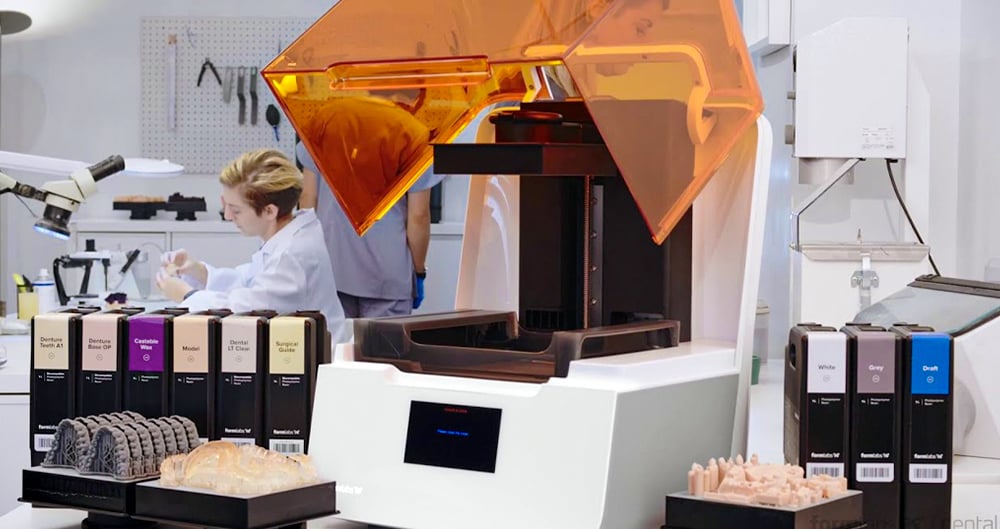
There’s no question that 3D printer sales among dental professionals is booming. Dental molds for clear aligners are one of the ideal applications of 3D printing: scan the patient’s mouth and send the digital file directly to your 3D printer. But dental academics in Italy at the San Marco Polyclinic University wanted to know which type of 3D printer (SLA, DLP, LCD) makes the best models, so they put four to the test.
Their study, recently published in the international Journal of Dentistry, aimed to evaluate the accuracy of orthodontic models for the production of clear aligners generated with printers featuring different technologies and belonging to different market segments.
Researchers 3D printed 80 identical dental models from two master digital files (.stl) on four different 3D printers: Asiga Pro 4K65, Elegoo Mars Pro, Formlabs Form 3B, and EvisionTec Vector 3SP. Each 3D printed model was scanned and superimposed with the master file to analyze deviations and evaluate trueness and precision.
The findings, not surprisingly, found that, although all four printers produced models within the accepted clinical error for producing clear aligners (< 0.25 mm), the SLA printers from Formlabs and EvisionTec (which was acquired by Desktop Metal) were the most accurate and the DLP technology for the consumer-grade Elegoo Mars Pro showed a “higher precision error”.
Roboze Aims to Accelerate Production of Industrial Tools With New 3D Printers
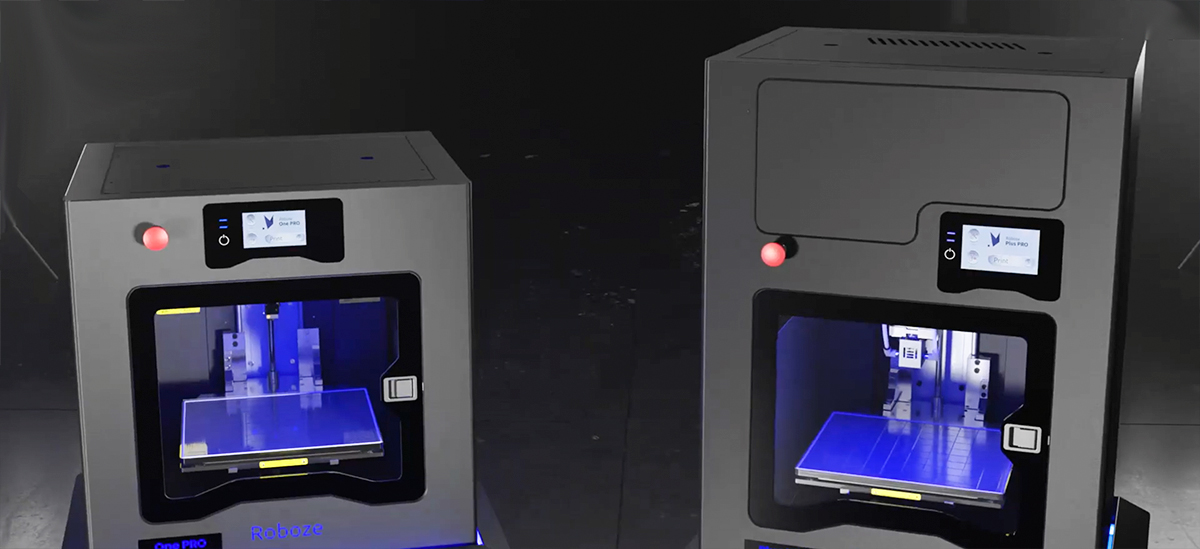
Roboze, the Italian maker of industrial 3D printers with an office in Texas, wants you to ditch the cast aluminum and CNCed stainless steel you’ve been using to make your shop tools, molds, fixtures, and spare parts. 3D printing with engineering-grade polymers, such as carbon-fiber Nylon and PEKK, on the company’s two new single-extruder, high-temperature FDM 3D printers is faster, easier, and more versatile, they say.
The two new machines – the One Pro and Plus Pro – aim to shorten the prototyping and production phase of small components and high-performance tools with a host of new features.
Particularly interesting is the new integration of the Pro printers with the Roboze proprietary slicing software called Prometheus. New profile settings within Prometheus enable more click-and-print manufacturing and less manual settings. The UltraFast print profile within the slicer accelerates the printing speed when printing with Carbon PA and the Ultra-PLA, the company says.
Prometheus’ UltraQuality profile results in extremely detailed parts when printing with PEEK, Carbon PEEK, and Roboze’s new ToolingX CF.
Adios Digest! All3DP Set to Give Readers a Better Industry News Experience
We know you appreciate having one link where, every week, you can catch up on the 3D printing industry news that’s really of use to you and your business, so we’re going to improve upon our news coverage here at All3DP to give you more of what you love. Stay tuned to the All3DP Pro homepage.
3D Printing Industry News - Week 25, 2022
Every Tool Shop Should Have a 3D Printer
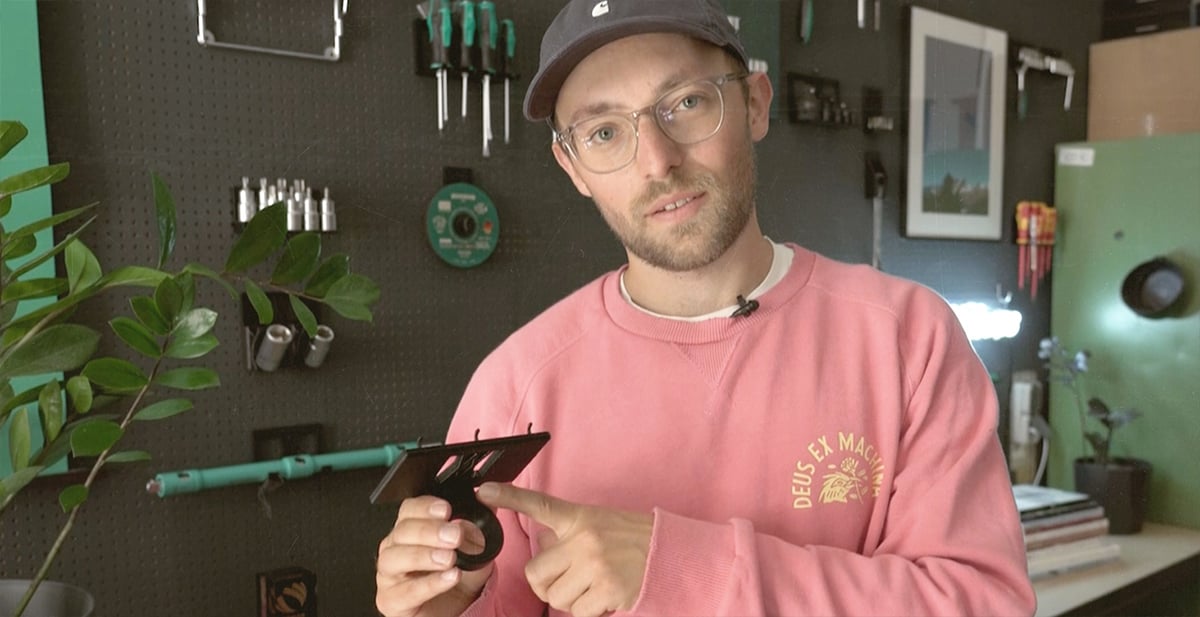
The hand tool market must be hard to break into since the design of a hammer hasn’t changed dramatically in hundreds of years. But that didn’t stop one ambitious start-up from thinking they could bring innovation to this industry with additive manufacturing.
Frankfurt-based Wiesemann 1893, founded in 2017, sets itself apart by relying on 3D printing for rapid prototyping of its products, designing 3D-printable tool holders anyone can download and print themselves, and also teaching loyal customers about how 3D printing and tools work hand-in-hand.
At first Wiesemann 1893 turned to rapid prototyping through external service providers to quickly get new products to market and respond to customer demands. The resulting wait times to get simple parts, however, meant fewer options for iterations and much less creative freedom in their designs. To accelerate their prototyping, they brought in their first 3D printer, the MakerBot Method X.
“We focus on quality designs and try to deliver the highest quality possible,” says Manuel Siskowski, the company’s CEO. “To do that, it is crucial to test a lot and iterate quickly.”
3D printing in-house led to the realization of how much customers could also benefit from 3D printing their own tool accessories, and anything else their project or shop may need. As a result, Wiesemann 1893 launched Enable 3D in 2020. This platform offers more than 100 3D models of tool holders and accessories customers can print on their own or order. The digital files can be downloaded for free and the platform has been so successful that Wiesemann 1893 now offers it to other companies who similarly want to enable their customers with 3D printable objects.
The company, in partnership with Makerbot, also offers advice on selecting and using 3D printers further cementing the fact that 3D prints are an essential tool in any shop, right next to the hammers.
Three New Printers This Week: 3DCeram’s C1000 Flexmatic, Flashforge’s Guider 3 Plus, 3ntr's Sequoia
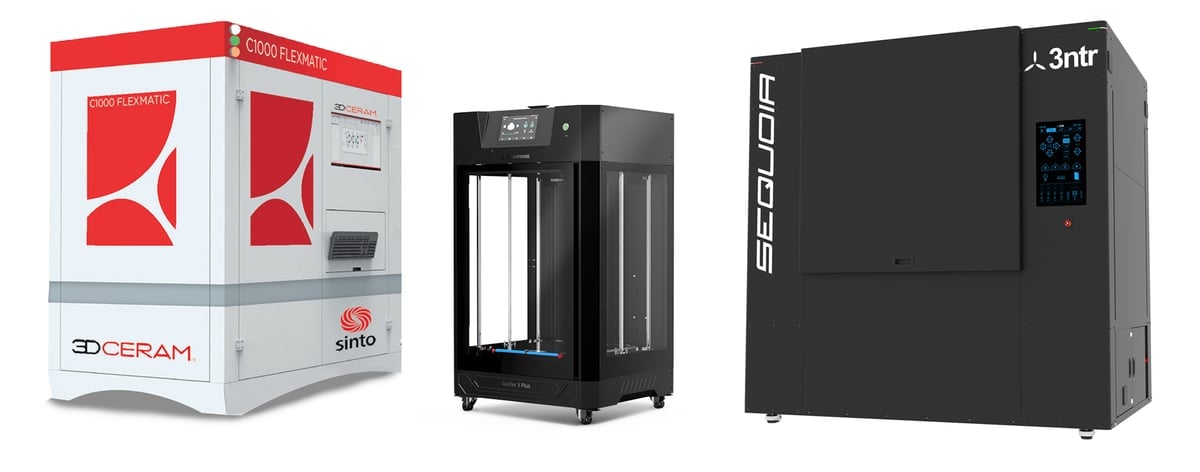
Based in France, 3DCeram has been making ceramic 3D printers for biomedical, aerospace, and other advanced applications for 15 years. This week, the company launched its newest ceramic SLA, the C1000 Flexmatic.
Filling a size gap between the company’s C900 and C3600, this machine has a build volume of 320 x 320 x 200 mm and is dedicated to large-scale production of ceramic parts, the company says. The C1000 Flexmatic features the company’s top-down stereolithography that enables prints without supports. The tray moves down as the part itself is built from the bottom-up.
3DCeram develops its own materials, which are a zirconia, HAP, alumina slurries cured by lasers.
Flashforge, the China-based manufacturer of a wide range of consumer and professional 3D printers debuted its Guider 3 Plus FDM machine that boasts higher print speed and precision than its previous machines.
Designed for small businesses, studios, and schools, the Guider 3 Plus features a 350 x 350 x 600 mm build volume, a high-temperature 320℃ extruder, a heated bed to 120℃, and a fine layer height of 0.05 mm. This machine features an open material system compatible with third-party filaments.
Flashforge hasn’t released the price, but based on its other models, we estimate the Guider 3 Plus to retail around $2,500.
The engineers at Italian 3D printer manufacturer 3ntr have been hard at work to get three new printers ready to launch this year.
This week the company gave a sneak peek of its new industrial FDM called Sequoia with an impressively large build volume, 1,200 x 1,100 x 90. The machine offers a heated chamber (to 130°C) and a high-temp extruder (to 450°C) that’s been redesigned for faster printing, the company says.
3ntr also teased two new medical 3D printers, A2MD, and the A4MD, that are versions of their existing industrial FDMs.
3D Printing Industry News - Week 25, 2022
In 3D Printing, Seeing Is Believing
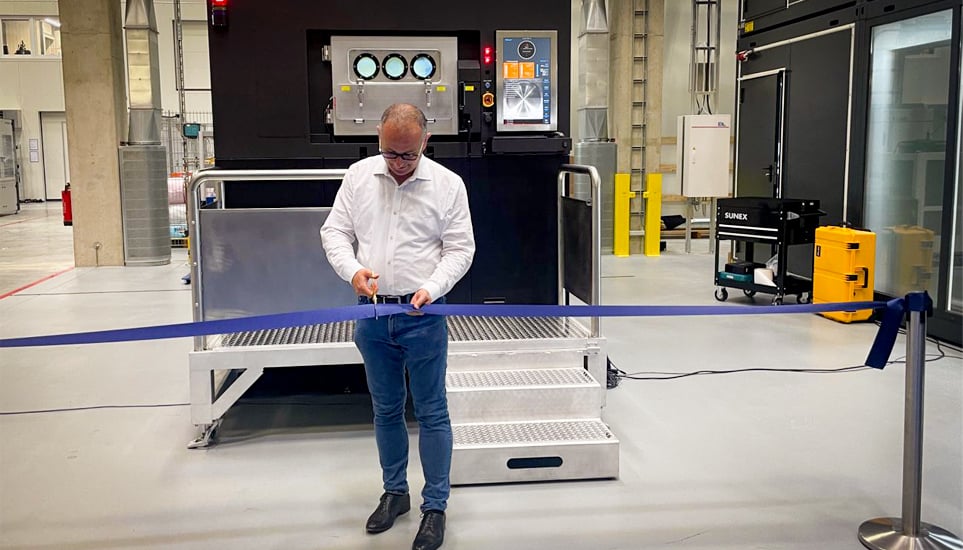
There’s a photo of US President Joe Biden at the event where he introduced his Administration’s AM Forward initiative to promote 3D printing in manufacturing, where he’s looking at a table of 3D printed items with a facial expression of complete awe.
When you see and hold 3D printed parts or watch 3D printers in action, you grasp the concept and the capabilities of the technology far clearer, and it is amazing.
To instill that sense of awe into potential customers, more 3D printer makers than ever are opening up showrooms and demonstration centers.
One of the latest is the European Technology Center from California-based Velo3D. The new 110-square-meter facility in Augsburg, Germany, will have a lab area for the company’s Velo3D Sapphire printer, a showcase of parts printed using the technology, along with offices and conference rooms for hosting training and events.
Crossing the pond in the other direction, Munich-based EOS just announced plans to open a new facility in Los Angeles by this fall. The new additive manufacturing innovation center will serve as a general-purpose west coast hub for EOS customers to see and learn about the company’s 3D printers.
Also opening this week, French 3D printer maker AddUp expanded its presence to the US and opened a new Solution Center in Cincinnati, Ohio. The nearly 2,000-square-meter facility will be used not only as a demonstration facility for both powder bed fusion and DED technologies, but also as a facility to provide metal AM printer services and training for US customers.
Not to be outdone, tech-giant Siemens recently announced its new Charlotte Advanced Technology Collaboration Hub, which will be located in Charlotte, N.C. and house 3D printers from several manufacturers including ExOne, Xerox, and Roboze. This hub focuses on helping companies accelerate their plans for the industrialization of additive manufacturing.
Foaming Resin for 3D Printed Parts That Poof When Heated
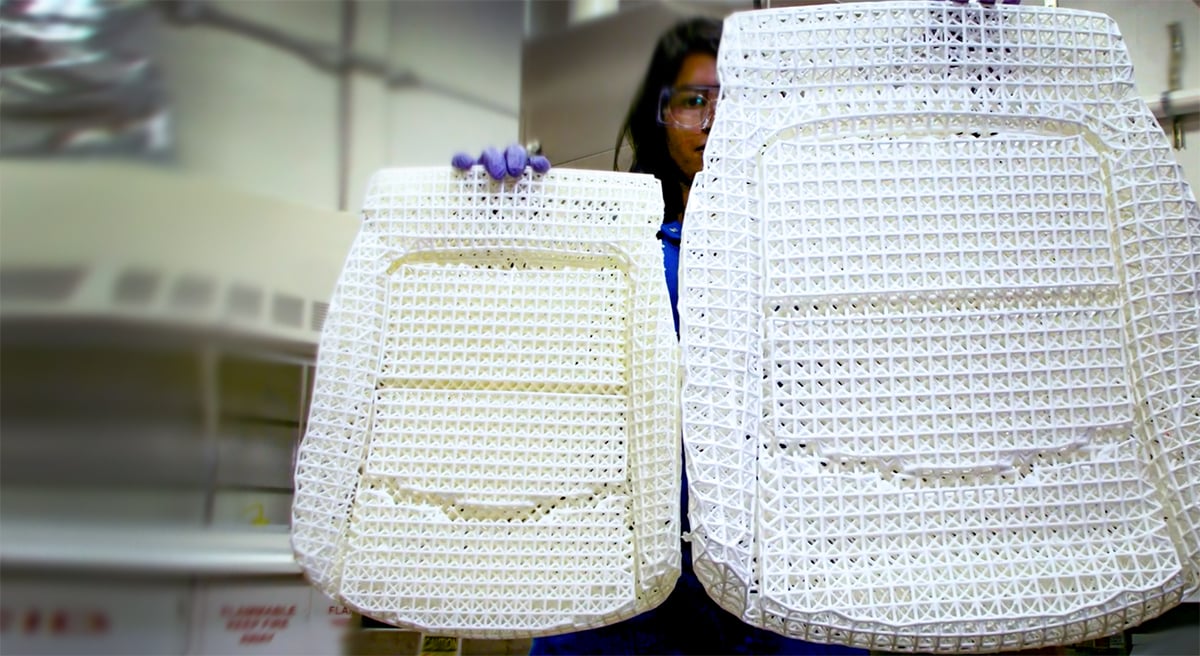
Desktop Metal this week unveiled a new family of photopolymer foaming resins that expand when heated. Designed for 3D printing lattice structure-type padding or fully dense foam, FreeFoam can be used to 3D print everything from automobile seat cushions to padding for sporting goods to healthcare products. Without the need for molds as tooling and eliminating the waste associated with traditionally manufactured foam products that are cut and shaped, 3D printing produces more complex shapes and variable stiffness padding with virtually no waste.
Desktop Metal says the highly controllable process causes FreeFoam resins to consistently expand 2 to 7 times their as-printed sizes depending on the grade of resin, achieving final parts within desired tolerances. This feature enables FreeFoam parts to be shipped in a compact form and expanded on-demand in an oven close to the final point of use or assembly, saving shipping and inventory expenses. This new process allows 3D printers to produce much larger final foam parts than the printers’ original build areas.
FreeFoam resin will be offered in a wide range of Shore hardness values and will initially be 3D printable exclusively on the ETEC Xtreme 8K top-down DLP system from Desktop Metal’s polymer 3D printing brand.
FreeFoam was invented and developed by Texas-based Adaptive3D, a subsidiary of Desktop Metal that was acquired in 2021. The resins are 3D printed similar to other photopolymer resins using DLP. The printed parts contain dispersed heat-activated foaming agents that create closed cell pores inside the material.
3D Printing Industry News - Week 24, 2022
3D Printing Pastries Like Only a Parisian Can
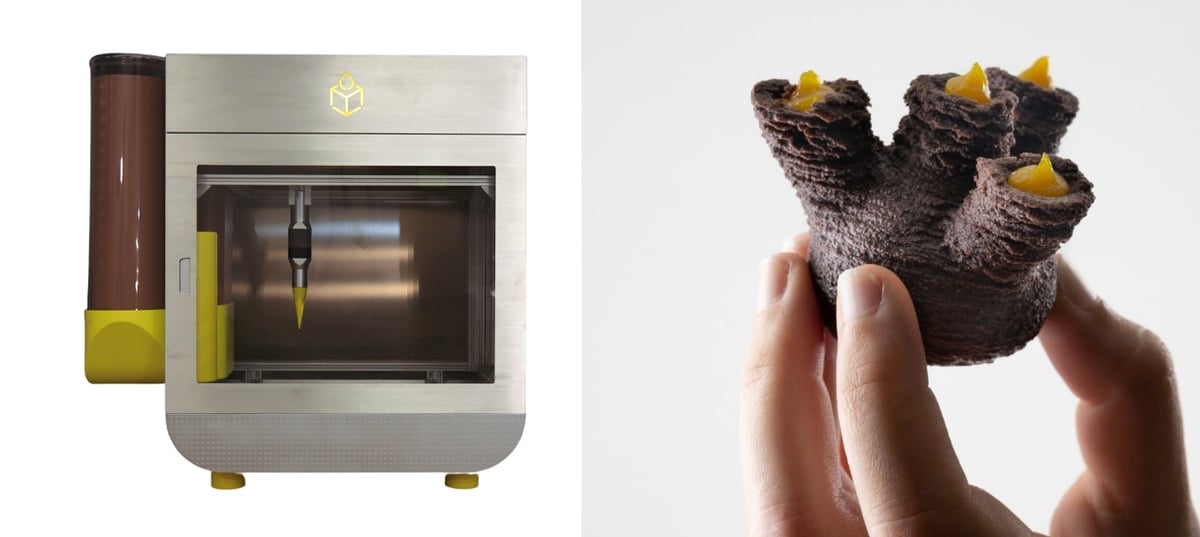
Maybe because it’s French that I have more confidence that this new cookie 3D printer’s products will be delicious. I’ve tried a fair amount of 3D printed food, and, well, flavor isn’t always the priority.
With the new Patiss3 by Paris-based The Digital Patisserie (La Patisserie Numerique), chefs can use their own recipes without having to make compromises for extrude-ability.
“It’s a powder-based process that enables us to work with French classic pastry recipes, without any additives,” says Marine Coré Baillais, the company’s founder, who left her position as deputy CEO of 3D printing service bureau Sculpteo in 2019 to pursue her passion of the culinary arts.
La Patisserie Numerique gave birth to Cakewalk 3d, the culinary extruder compatible with 3D printers in 2019 and designed slicing software for 3D food printers. Since the release of Cakewalk 3d, the Patisserie Numerique team has grown and focused on the development of a new food 3D printing technology.
The photo above shows the 3D printed chocolate cookie dessert called Coral, made of chocolate mousse, meringue, cocoa shortbread, and fruit confit. As is the case with many 3D printed parts, this one is not possible with traditional pastry making techniques unless it is assembled from several peaces.
“The ambition of La Patisserie Numerique is to free up time for professionals so that they can focus on taste and creativity,” says Baillais. “Our new 3D printer allows us to produce any shape of a cookie, according to your own recipe … The result is a low-sugar, non-doughy cookie that meets the standards of the French pastry.”
As with many 3D printed parts, some post-processing is required. In this case baking, which definitely smells better than annealing.
Patiss3 can work with a wide range of edible raw materials. Only 25 machines are currently in production and after two years of development, Patiss3 will be available from September 2022. Aimed at professionals, the printer can be rented from €500 a month.
Ultimaker Officially Joins the Metal Filament Club
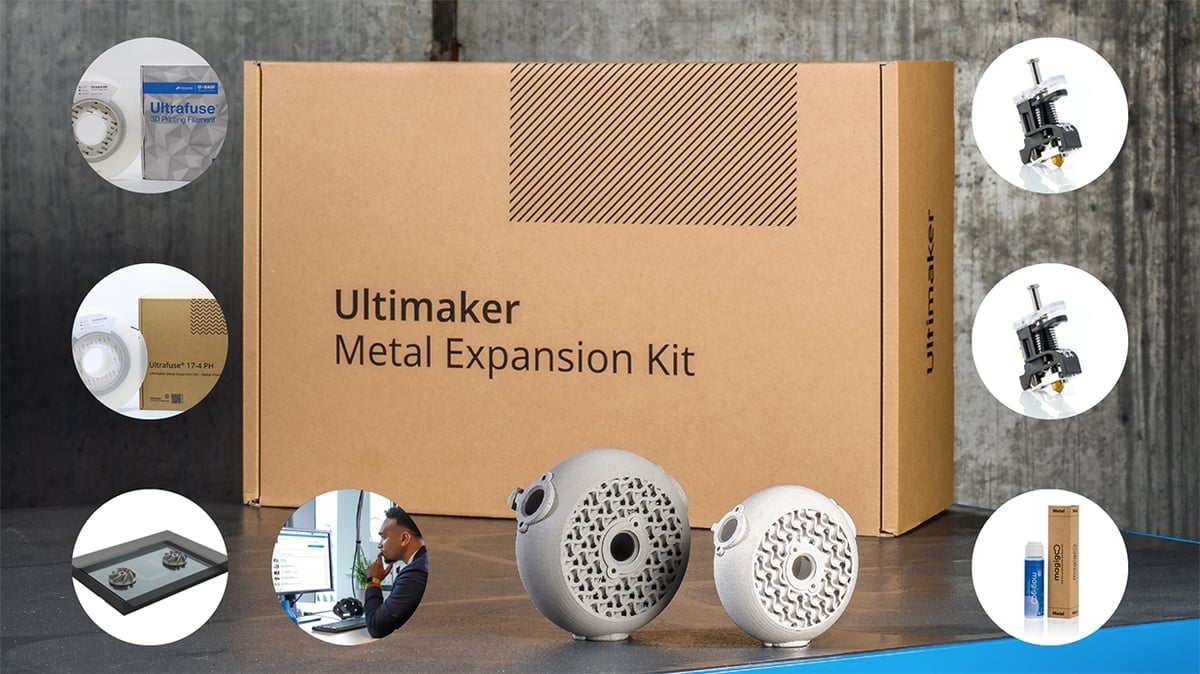
Ultimaker users have been able to print full metal parts on the company’s S5 machine ever since the printer profile for Ultrafuse 17-4PH by Forward AM was released in 2021. But now, Ultimaker is promising a completely new experience.
This week, Ultimaker released its Metal Expansion Kit which includes the Ultrafuse stainless steel metal filament with an NFC that enables the S5 to automatically recognize the material and launch the print profile; Ultrafuse Support Layer filament (only available in Europe); two dedicated print cores; Magigoo Pro Metal adhesive; and access to Ultimaker 3D Printing Academy content to help you get the most out of your metal printing.
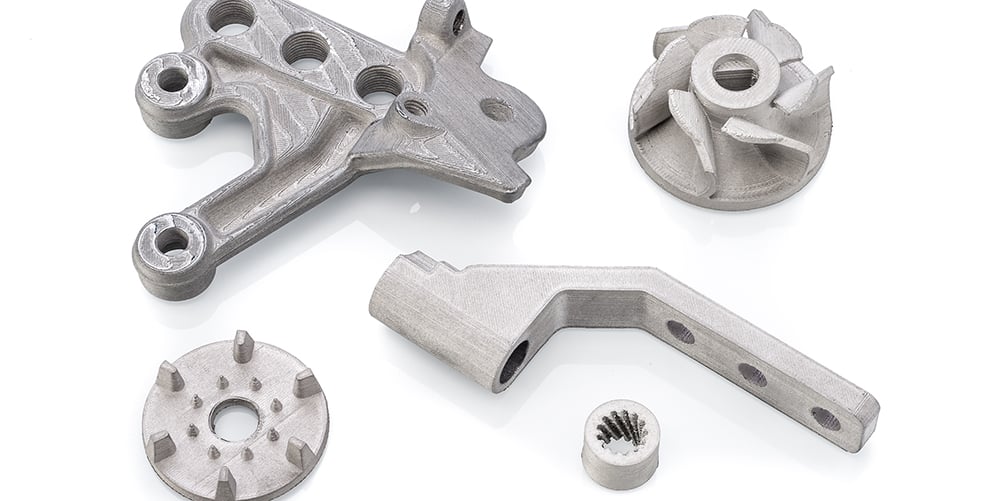
The support material is one of the interesting points. It’s more of a layer between the metal part and the metal supports than enables easy breakaway of the supports.
The parts you print with metal filament on your Ultimaker aren’t usable off the print bed. Like all metal filament, these “green parts” need to be post-processed to become solid metal parts so the Ultimaker kit also includes handy packaging to send your part off to a Ultrafuse post-processer near you, and a voucher to cover the cost.
Ultimaker wasn’t the first FDM printer out of the gate with a metal kit. Printer maker BCN3D introduced its Metal Pack back in November 2021 that similarly includes Ultrafuse stainless steel filament (both 316L and 17-4 PH), the Magigoo adhesive, and two hotends for about $1,000 in all. But Ultimaker’s changes to its Cura software, that include automatic and assisted shrinkage calculations and other handy settings, may make printing with metal filament far easier and more predictable than before.
New Micro-Scale 3D Printing Resins Expand Applications
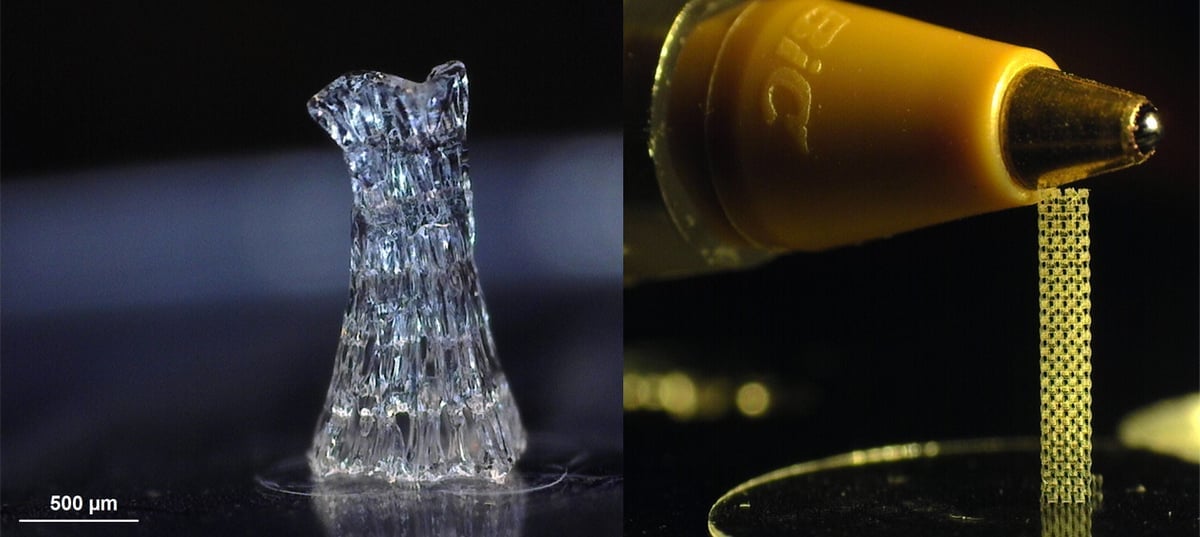
Because micro-scale resin 3D printing requires unique materials formulated specifically for this technology, called two-photon polymerization (TPP), the range of usable materials plays a significant role in its adoption and potential applications.
This is why the release of eight new TPP resins from French micro-scale 3D printer maker Microlight3D is such big news. The new resins broaden the opportunities for mechanical and life sciences researchers to 3D print complex objects at the micro-scale. The range of flexible, rigid, and biocompatible resins creates opportunities for developers to explore 3D microprinting using different materials and reproduce miniscule objects, 100x’s smaller than a strand of hair, in complex designs.
Microlight3D’s resins are for use with its microFAB-3D resin TPP printer.
“We are pleased to offer an extended range of resins that will enable our users, who have an amazing appetite to try new things, to fully exploit our 3D microprinting systems,” said Philippe Paliard, head of the 3D printing laboratory at Microlight3D. “As many conventional 3D printing resins do not automatically work with two-photon polymerization (direct laser writing) methods, our latest selection of new resins fills this gap.”
The company’s two rigid resins (Rigid-A and Rigid-E) along with its flexible resin (Flex-A) are designed for micromechanics applications, such as micro-grippers, screws, and micro-architectured materials.
The OrmoRed resin, used with an infrared laser, enables researchers to use different materials within the same system, and thus enhance the OrmoRed resin with metallic or magnetic nanoparticles to create, for example, innovative micro-robots.
The new OrmoBio and Green-A-Bio are biocompatible resins, while Green-Gel and UV-Gel are two biocompatible and ductile hydrogels, which are important for researchers in cell culture.
In addition to the new resins, the microFAB-3D remains compatible with many commercially available polymer materials widely used in micro-optics.
3D Printing Industry News - Week 23, 2022
3D Printing Poufs & Planters at the Milan Design Week
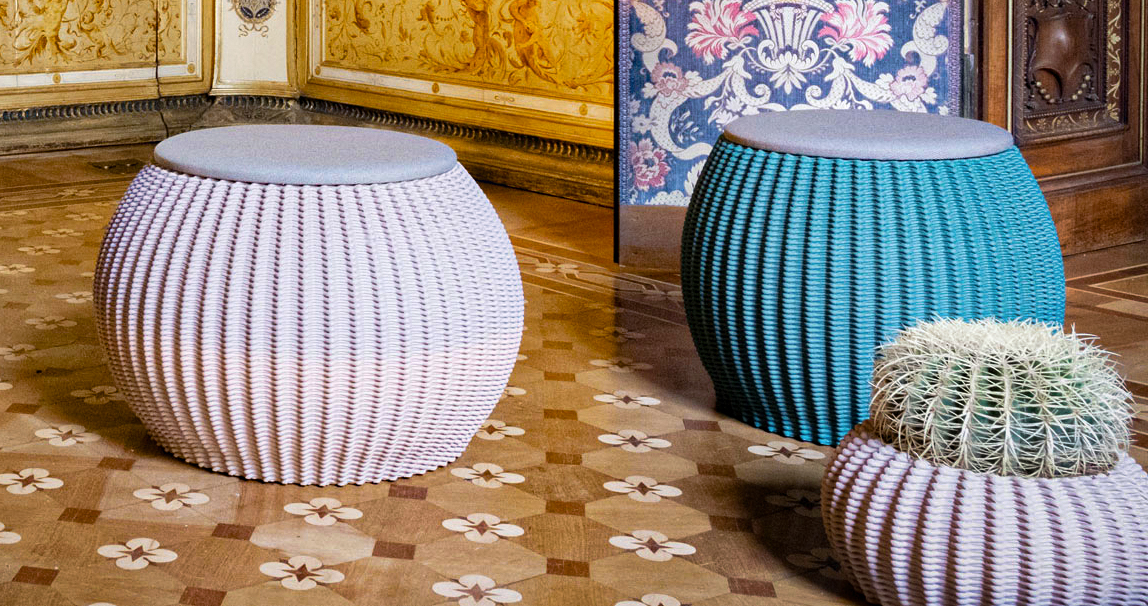
I’ve never wanted to own a pouf. Their practicality has always escaped me. But when you 3D print one out of recycled Tetra Pak cartons, they are suddenly far more appealing.
Aectual, the robotic 3D printing design firm out of Amsterdam, debuted their new earth-tone poufs at the Milan Design Week along with a collection of wall dividers, architectural elements, and interior design products made entirely from recycled drink cartons in partnership with Tetra Pak.
This concept tackles two problems: Roughly 40% of the material used in the global construction industry ends up as waste, and Tetra Pak recycling rate is currently around 26% worldwide, which is low because not all recycling facilities accept these cartons for recycling.
“Nearly 200 billion drink cartons are used annually,” says Hans Vermeulen, CEO and co-founder of Aectual. “The cardboard can be recycled, as well as the inner layer that consists of a polymer-aluminum mixture called PolyAl. PolyAl is available at a massive scale and we’re now able to create beautiful furniture and finishes with it.”
The furniture itself, including the poufs, can be shredded and re-printed into new products. The PolyAl holds up even after several cycles, the company says, and the matte-finish products has an almost ceramic feel.
The Aectual Drink Carton concept line demonstrates the material’s second-life value for new products for offices, homes, and the hospitality sector. Of course, it takes more than a packaging company and a 3D printing company to facilitate a fully circular material loop. The ecosystem is built with material recycling partner Recon Polymers and material science start-up Innolab Chemistry.
The products are digitally developed, so the portfolio of objects is customizable, and the hope is the project will boost Tetra Pak recycling and PolyAl applications worldwide.
Artec 3D Reengineers its Scanning Software
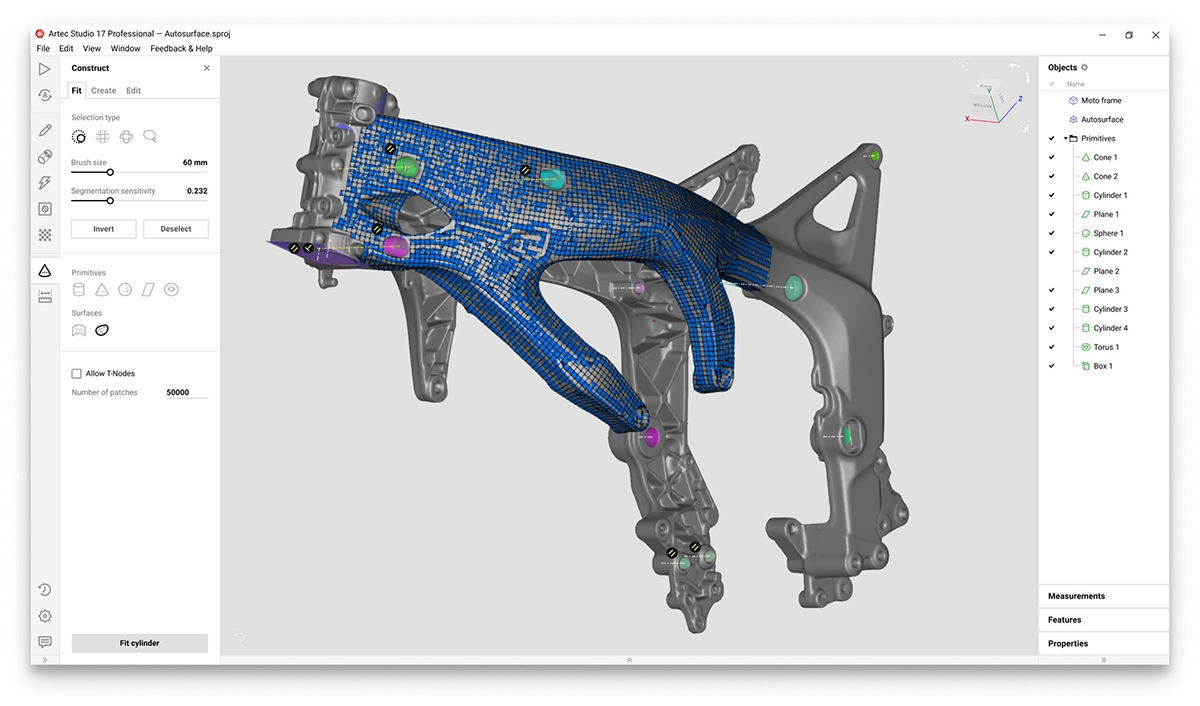
California-based Artec 3D, the 3D scanner maker, yesterday released the newest iteration of its 3D scanning software, Artec Studio 17. The company says the new version represents a “significant leap forward” for the product because of a host of new features and updates that promise better reverse engineering and quality inspection, as well as overall better speed and ease of use.
Artec Studio 17’s new features enable you to scan an object and completely reverse engineer it all in one software, the company says, streamlining design and manufacturing workflows. New tools enable one-click conversion of complex organic shapes into solid CAD models, while with the addition of Boolean operations, users can modify models with CAD entities and meshes using the union, subtract, and intersect tools to create products such as customized molds and packaging.
Artec Studio’s new photo viewing mode for applying high-resolution photos to high-accuracy scans refines the process for creating texture-perfect, professional 3D models for online use. Users can now easily preview photos and see how they fit to the geometry of the model and remove any images with defects, overexposure, and poor lighting. And now with the introduction of the new photo-texturing algorithm, images are automatically sorted and separated into groups: by size, camera type, or focal distance, allowing for simple individual registration.
New scan-to-CAD features enable metrology professionals to align meshes and CAD models using key geometric features in just a few clicks. Users can individually select objects, such as spheres or checkerboard targets, take measurements between any of these objects, or exclude any from registration if required. Additionally, users can now import multiple reference target clouds into the workspace and choose which ones to use for tracking.
Subscribers get automatic access to the latest version, while everyone else can take it for a test spin in a free 30-day trial.
Desktop Metal Expands to Precious Metal Binder Jetting
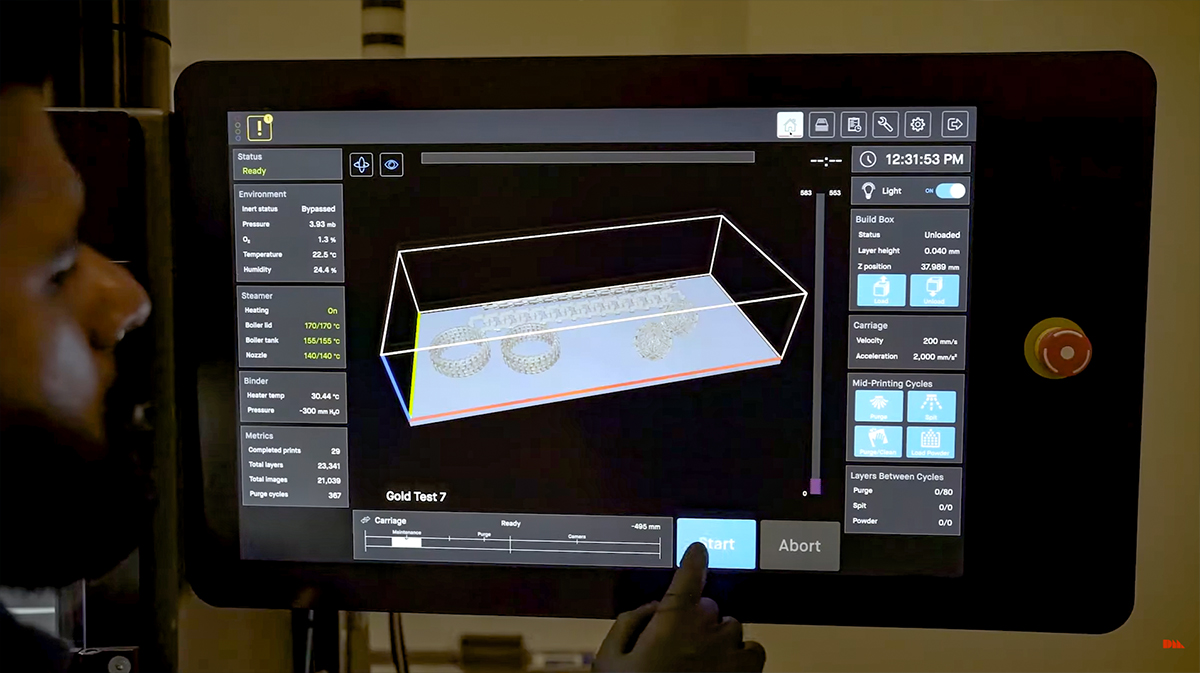
The folks at Desktop Metal, through their acquisition of resin printer maker EnvisionTec, have a lot of relationships in the jewelry industry built over the years by offering both desktop and production size 3D printers for making precision jewelry molds. They already count among their customers Cartier, Stuller, Shinola, and Swarovski. So they must be responding to customer demand with the introduction this week of direct 3D printing of sterling silver.
The Boston-based company announced 925 sterling silver is now available for binder jet 3D printing on its Production System platform. Despite the upfront costs of a powder bed full of sterling silver, Desktop Metal says the move offers jewelry and luxury goods manufacturers the fastest way to directly 3D print precious metal jewelry, watches, belt buckles, and decorative hardware for handbags.
“The qualification of precious metals for direct 3D printing on high-speed binder jetting systems is a major milestone for the jewelry and luxury goods industry,” said Ric Fulop, founder and CEO of Desktop Metal. “All the design freedom and customization of 3D printing can now be delivered directly at high volumes without all of the labor associated with traditional manufacturing processes.”
Doing away with molds promises to be a faster production method, even with the debinding and sintering steps, according to Desktop Metal.
High-volume jewelry manufacturers are the target audience for this material. For example, Desktop Metal says it already has a relationship with two leaders in precious metal powder and parts production; California-based Formula 3D Corporation and Switzerland’s Neoshapes.
Formula 3D Corporation’s founder Christian Tse says he can print in precious metals in two hours what used to take two days with casting. Neoshapes co-founder Stéphane Vigié says direct metal 3D printing enables companies to meet demand while maintaining minimal inventories
Desktop Metal is also fast-tracking the development of additional precious metal alloys in 2022, including 18K yellow gold.
3D Printing Industry News - Week 22, 2022
3DGence’s New Material Systems is More Than a Drying Cabinet
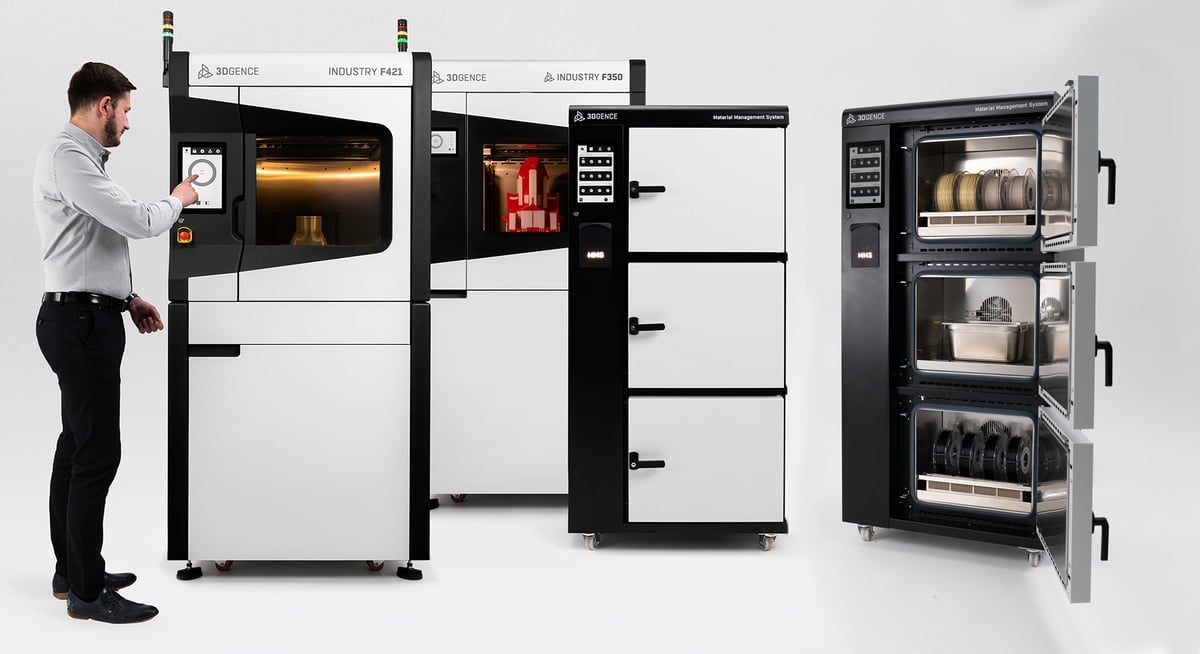
As manufacturers 3D print with more sophisticated (and expensive) filament, the requirement that these materials be kept dry and in the best condition can present a problem. There are just a handful of filament dryers on the market and most aren’t incorporated into the digital additive manufacturing process and many lack automation.
That was part of the inspiration for the new multi-material management systems from 3DGence. Yes, it dries filament with active hot air that can heat from 50°C to 200°C, but it’s also automated to help with the otherwise cumbersome activity figuring out the optimal drying temp and time for different polymers, and the best humidity to store them plus the cabinet can be used for heat post-processing.
The cabinet also has real-time connectivity to 3DGence Connect, the company’s software dashboard and cloud platform. When you scan spools of filament by the NFC tag, each material is processed according to the manufacturer’s requirements. You can see from the cloud platform exactly which compartment in the cabinet it should be and how long it’s been there. If you 3D print in regulated industries, such as aerospace, military, medical, and automotive, you know how important material and process traceability is.
The Material Management System also has an annealing feature to finish PAEK parts to enhance part strength up to 75%, the company says. The annealing compartment is programmed and configured for Anneal AS9100 PEEK, Victrex AM 200, CF-PEEK, and other certified materials through a few short steps in the system’s interface.
The cabinet will dry and store 4 spools or six spools with an optional add-on. The user interface and workflow is operated from the built-in 10-inch touchscreen. Other options include a print recrystalization kit, drying agent cartridges (one for each drying chamber), and drawers for storing materials in the drying chamber.
I know what you’re thinking: This looks ideal, but will it work if I don’t have a 3DGence printer or materials? The cabinet doesn’t physically attach to 3DGence’s printers but it does require the 3DGence Connect software. Currently it only recognized the NFC tags of material purchased through 3DGence, but the company says it plans to expand to other materials in the future.
Evatronix Reengineers Its Dual-Band 3D Scanner
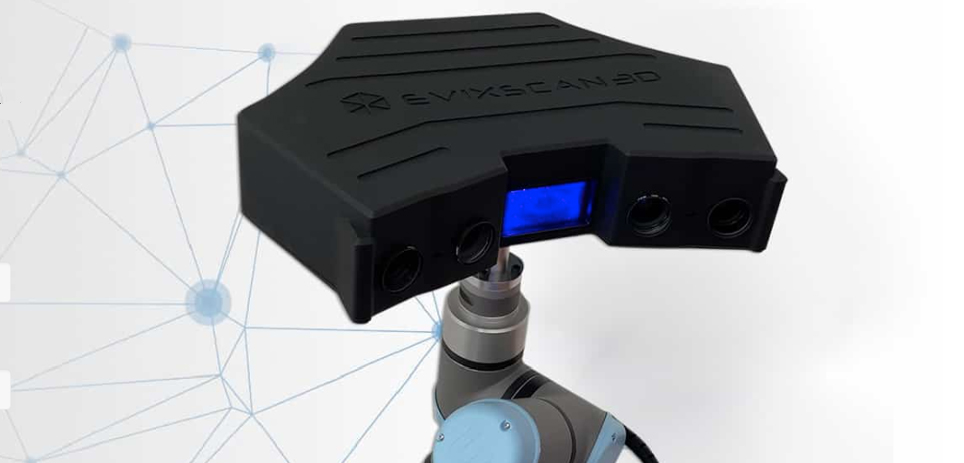
Evatronix unveiled a reengineering of its popular HD Quadro 3D scanner this week that boosts its accuracy for other near and far scanning.
The EviXscan 3D Quadro+ is the company’s new dual-band scanner, meaning it has two scanning ranges: a precise inner range designed for small-part (120 to 450 mm in size) detailed scanning and an outer scope with a much larger working field for faster scanning of larger objects (from 250 to 1000 mm).
Evatronix says changing the scanning range is now done in the software so no recalibration of the scanner is required after changing the range. Also, if you have scans from two different scopes with Quadro+, you can combine them using the EviXscan 3D Suite 2.8. This solution significantly speeds up the work of measuring objects, the company says, where certain parts require scanning at a high resolution, which is not necessary when scanning other parts of the object. This ability to combine point clouds from two scopes significantly increases the range of applications for this scanner, Evatronix says.
Quadro+ is equipped with four high-resolution cameras: two 9-megapixel cameras for the outer range and two 12-megapixels for the inner range. Evatronix says the scanner has a new projector equipped with a blue LED light source to obtain a 1080-pixel resolution image. The low wavelength of blue light enables better filtering of ambient light.
Also new on the + version of the Quadro is a vacuum cast housing, which makes it significantly lighter than the aluminum housing of the previous model and enables it to work with more robots and cobots.
Tech specs:
- Light source type: Blue LED
- Number and type of cameras: 2 x 12 Mpix , 2 x 9 Mpix
- Scanning accuracy: up to 0.007 mm
- Scanning time: 1.2 second
- Measuring range: Inner: 220 x 160 x 90 mm, Outer: 450 x 225 x 180 mm
- Points density: Inner: 351 pt/mm2, Outer: 88 pt/mm2
- Export formats: stl, ply, obj, asc, bin
- Hardware requirements: Windows 10 (64 bit)
- Software: eviXscan 3D Suite
3D Printing Industry News - Week 21, 2022
New AM Software Aims to Connect the Digital Dots of Serial Production

If you’re looking for software to run your additive manufacturing operation, there may be no better place to look than one of the largest software developers in 3D printing who also happens to run one of the world’s largest 3D printing services.
Undoubtedly born out of their own need to optimize their huge multimachine 3D printing factory, the CO-AM Software Platform from Belgium-based Materialize is their way of sharing their expertise.
As an additive manufacturing service provider, Materialise is tasked with managing on-demand serial production for its clients as well as thousands of on-off part orders. They offer everything from PLA prototypes to titanium aerospace parts that have to pass strict certifications, plus engineering and design services. They know firsthand the difficulties of coordinating and tracking 3D printed parts on the entire journey from design through post-processing.
CO-AM, still in beta testing with a few undisclosed clients, is a clout-based platform hub that will integrate all of your manufacturing, CRM, and design applications into one additive manufacturing space.
Materialise, which make the popular Magics software, will bundle its own software, new software it is developing, with APIs for approved external software into a platform to help you plan, manage, and optimize every stage of your AM operation.
“The open architecture of the platform lets users integrate all of their preferred tools, allowing customers in major manufacturing industries, including aerospace, automotive, consumer, medical and energy, to always have access to the latest software innovations and to scale their operations based on their current needs,” says Materialise.
At the heart of the CO-AM platform is a data lake that connects to all of your 3D printers and keeps track of what is happening on the production floor. The ability to first monitor and analyze production data will enable you to define and store your own unique workflows in a knowledge database that’s a stepping stone to continuously improving production processes. This creates an AI-powered learning platform where every printed part has the potential to be better than the previous one.
Materialise says there’s untapped potential to use AM for serial manufacturing and mass personalization and part of tapping into that is software that helps companies move from 3D printing for prototyping to production.
“AM production still requires a lot of skilled manual intervention and disconnected data makes it hard to achieve the consistent and repeatable quality standards that are needed to mass-produce identical or customized products,” the company says.
Materialise plans to offer more than 25 software applications on its CO-AM platform, including a seamless integration with Magics and more than 150 different 3D printers. The company will also open the platform to independent software vendors and has already onboarded several third-party applications, including AM-Flow and Castor.
There’s not a lot of detail available yet on CO-AM since Materialise is still working with select AM software vendors, development partners, and selected customers, but the potential is there to really kick-start 3D printing for production, especially among the world’s growing community of 3D service providers.
Photocentric’s New Resin Printer Doubles Speed, Targets Production

UK-based resin 3D printer maker Photocentric just launched what it says is a completely re-engineered desktop resin printer. The new LCD screen-based Liquid Crystal Magna v.2 is “significantly faster” than the previous version, Photocentric says, and features upgraded electronics, including a new control system and interchangeable platforms, all aimed at improving reliability and performance. On the outside, it looks the same as the previous version.
When it comes to speed, Photocentric says the Magna v.2 prints at 16mm per hour depending on the resolution. By way of example, the company says 36 custom dental trays (80-mm Z height) at 250-micron layers can be printed in 1 hour 13 minutes, compared with 2 hours 22 minutes on the previous version of the LC Magna. So, twice as fast as the previous version of the Magna.
Tech Specs
- Build volume: 510 x 280 x 350mm
- Print layer thickness: 25, 50 and 100µm.
- Resolution: 4K screen. 3840 x 2160 px
- Print Speed: 16mm per hour
- Cure Speed: 2 seconds per layer at 100um
- Light output wavelength: 460nm
- Price: ~ $22,000 – $26,000
- Software: Studio, Additive (optional)
Launcher Set to Trailblaze with 3D Printed Space Rockets

Aerospace company Launcher’s new Orbiter satellite platform, powered by 3D printed engines, is set to lift off with SpaceX this fall and vastly expand satellite deployment.
f all goes as planned, Launcher, a California-based space flight vehicle and 3D printed rocket engine maker, will hitch a ride on SpaceX’s Transporter-6 to carry its Orbiter satellite transfer vehicle and platform into space. There, it will deploy several CubeSats and small satellites, and precisely place them into whatever orbit their owners desire.
Launcher, founded by Livestream entrepreneur Max Haot in 2017, aims to dramatically lower the cost of launching small satellites into orbit, which will expand opportunities to a wide range of customers. The manifest is already booked for the October launch and includes satellites from cubesat start-ups Skyline Celestial, Innova Space, and NPC Spacemind, and two others for Stanford University and Cal Poly Pomona.
The Orbiter satellite platform will also deploy payloads for Beyond Burials, a space memorial service start-up, and Cesium Astro’s communications system.
Haot plans to be a big part of what he refers to as a small satellite revolution made possible, in part, by the cost reductions and manufacturing acceleration of 3D printing. “We believe there will be hundreds of thousands of small satellites in orbit within the next decade,” he says.
Want More Pro Additive Manufacturing News and Features?
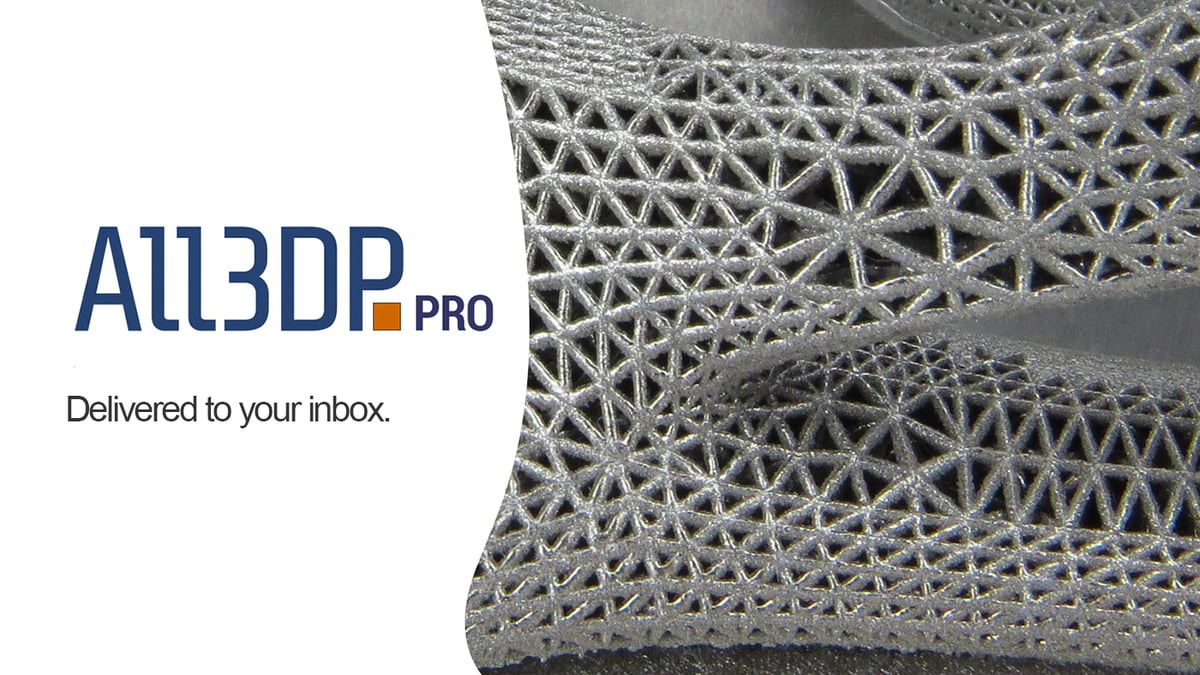
Sign up for All3DP Pro’s monthly newsletter and you won’t miss any new products, materials, or trends in additive manufacturing!
No one wants an inbox stuffed with reprinted press releases, industry executive promotions, 3D printing company stock performance, or university lab research findings that may never make their way in actual products you can buy.
You what analysis of the newest products, materials, and services that will keep you on the cutting edge and able to offer your customers something better, faster, and cheaper.
If this sounds like you, we’ve got a monthly newsletter that delivers just the top products, newest innovations, business cases, and advice you need to stay on top of additive manufacturing.
Sign up. Unsubscribe anytime.
3D Printing Industry News - Week 20, 2022
Daimler Launches Trailblazing 3D Printed Spare Part Program

If you’ve ever waited on a car repair because your local garage had to order parts from the manufacturer, you’ll understand how revolutionary the new Daimler Bus program announced this week is. Imagine a future where your local car garage can 3D print certified and branded repair parts from a Ford, Toyota, or BMW digital warehouse.
Daimler Buses is taking the first step in this direction by enabling bus and touring coach companies to additively manufacture spare parts themselves starting next month.
Owners and service companies of Mercedes-Benz and Setra buses can 3D print spare parts quickly and cheaply at their own premises, Daimler says, as long as they have a certified 3D printer, a one-off registration process, and a license for the required part in the desired quantity.
“Thanks to the new license management for spare parts, the Omniplus service brand from Daimler Buses is charting the course for the entire automotive industry,” the company said in its press release.
From June, more than 100 parts of the currently more than 1,500 3D printable components will be available as the first licenses from the Daimler digital warehouse. Additional spare parts will follow as digital licenses. This blend of e-commerce and digital warehouse with deep encryption technology and traceable part production is an impressive piece of technology. It’s designed to eliminate supply chain challenges and cut costs for consumers while ensuring part integrity and any loss of spare parts revenues for Daimler.
Here’s how it works. At the online part shop, customers are only shown the parts that are available for or compatible with their own printer. Currently, the only printer manufacturer certified for the program is Farsoon, but Daimler promises more as the program goes forward.
After having successfully printed the component part, the respective license expires without the data being saved, so customers can’t, theoretically, print dozens of parts and them sell them.
If you don’t have a 3D printer there’s an option to order the parts 3D printed locally at an Omniplus service partner, which is likely a 3D printing service provider, perhaps companies like Materialise, Fast Radius, or Protolabs will sign on to programs like this in the future.
The benefits are clear; spare parts are made available worldwide in the quickest possible way, and exactly where they are needed.
A Step Closer to Standards for 3D Printing Materials

What makes one company’s tough resin different from another’s and how do you pick the best carbon-fiber-filled Nylon filament from the vast array of options? If 3D printing materials are a mystery to you, more help may be on the way.
ASTM International, formerly known as the American Society for Testing and Materials, is an international standards organization that develops and publishes voluntary consensus technical standards for a wide range of materials, products, systems, and services. The group’s Additive Manufacturing Center of Excellence announced this week that it aims to standardize how we describe material properties for 3D printing materials, and bring some consistency to material datasheets. And it’s not a day too soon.
Currently, 3D printing material datasheets are typically a jumble of inconsistent data with manufacturers using different testing methods and even different measurements for material characteristics, such as tensile strength and elongation at break. That is if you’re lucky enough to get tech specs with your materials at all.
This new Consortium for Materials Data and Standardization (CMDS) initiative will bring key organizations together from across a broad range of industries representing the entire AM value stream to accelerate the adoption of AM technologies. The consortium is being launched with 21 founding members including, NASA, Auburn University, and Boeing, plus a long list of 3D printer makers, including Desktop Metal, EOS, and HP.
Especially as more 3D printers become open material platforms, it’s critical that users have a standardized way to evaluate and purchase materials. ATSM says the initiative is particularly focused on determining methods for generating machine agnostic materials data, which isn’t going to be easy considering the vast differences between many of the brands within a single technology category of additive manufacturing.
The end result, which may be years off, won’t be anything like the standard nutrition label on foods. Instead, each year, the CMDS will select materials and application-specific properties (e.g., static, cyclic, thermal, corrosion) of interest and conduct projects that ultimately support the standards and datasets. Members of the consortium will be allowed to use the full datasets in their product marketing, and the research and lessons learned will make their way into other ATSM initiatives to drive consistency across the industry, they say.
There’s a section within the Biden Administration’s AM Forward program to drive AM adoption announced a few weeks ago, that covers establishing standards in the industry. There’s no word from ATSM on whether they’re a direct partner with AM Forward, but they do say they’re coordinating with American regulatory bodies and government agencies.
Construction 3D Printing to Tackle Apartment Buildings
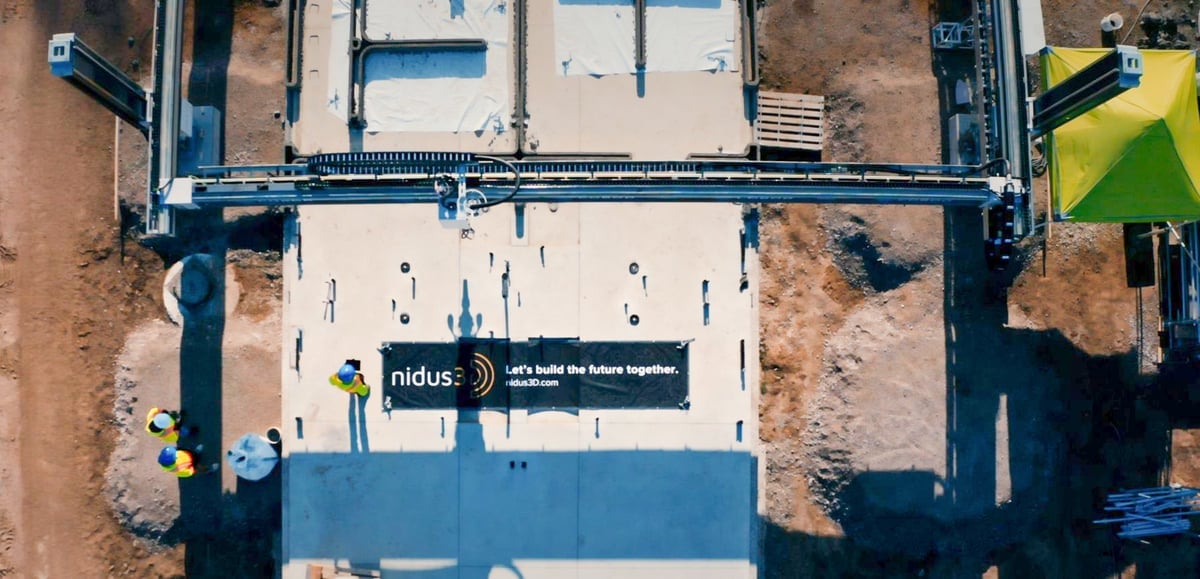
Ian Arthur, president and founder of Nidus3D, a 3D printing construction company that’s in the middle of building a multi-unit residential project in Canada, told the Winsor Star newspaper that once the project is finished, “you won’t be able to tell it’s a printed house.”
This is surely a disappointing statement to 3D printed house fans, but it’s also a sign that the technology is moving from being a novelty to achieving its touted purpose; to construct homes faster, cheaper, and better.
House-builder Habitat for Humanity, a partner in the project, said this multi-unit structure is a key step in increasing access to affordable housing in Canada and may be a game-changing solution to the current housing crisis.
“Nidus3D is driven by the mission for increasing access to housing, and we’re deeply honored for building the first multi-unit 3D printed homes in North America,” says Arthur. “This historic build serves as proof-of-concept for future builds, and paves the path for quicker and more cost-effective homes for Canadian families.”
The project, scheduled for completion by the end of this summer, will result in four units in a self-contained home with each unit measuring 560 square feet. Nidus uses a COBOD International BOD2 construction 3D printer.
Materialise Launches Magics Update for CAD & Mesh Editing, Workflow Solution
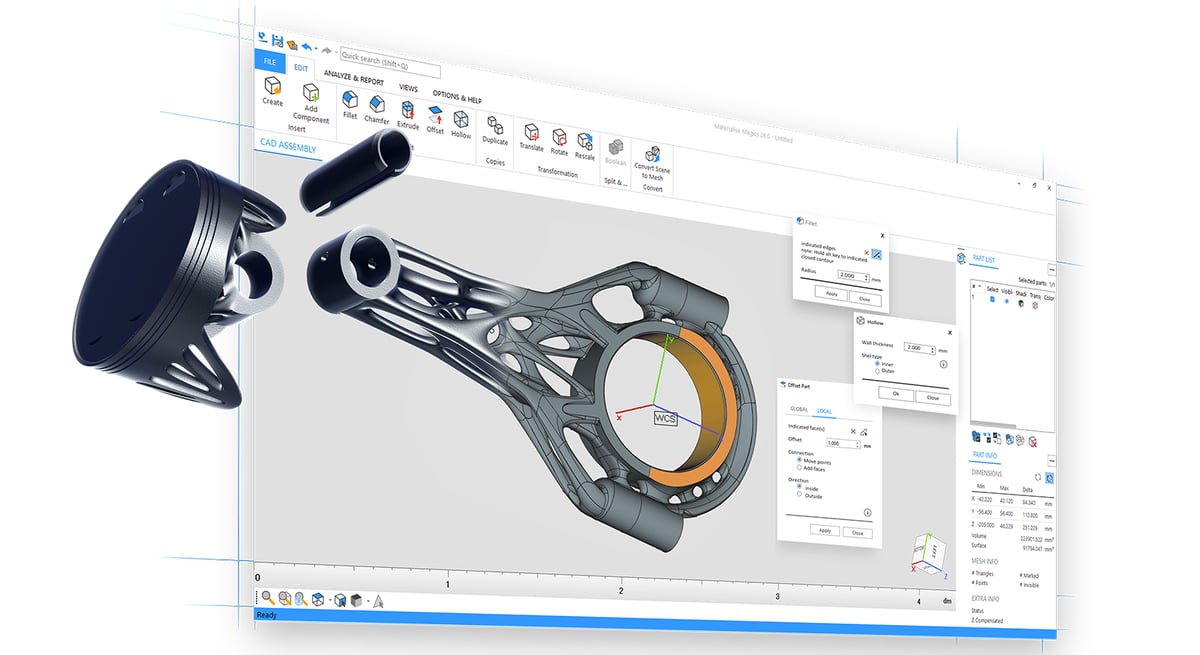
Materialise, the global 3D printing software and services company, launched the latest version of its data and build preparation software this week, Magics 26, with new features. More than slicing software, Magics simplifies build preparation whether you want precise control over your workflow or quick, optimized enhancements and support structures.
Magics 26 introduces a function in which users can edit CAD-based parts in addition to mesh-based parts for altering, fixing, analyzing, and build-preparation. You can choose your preferred workflow based on your 3D printing project requirements and edit their parts in mesh or in CAD format. Editing and saving parts in a CAD-native format enables Magics users to maintain part integrity and to use cleaner, high-resolution CAD files, Materialise says. “This helps to reduce the time between design iterations and improves stability and repeatability by preventing errors that may occur in transitions between file types.”
Other Magics 26 enhancements include advanced automated nesting and improved support generation, such as braced flexible cone and tree supports and the option to generate supports between parts when producing with electron beam melting and binder jetting.
Magics users interested in scaling up their operations for serial production and mass customization will also benefit from future integration with CO-AM, Materialise’s recently announced software platform. Building on the company’s acquisition of Link3D, CO-AM will allow manufacturers to plan, manage, and optimize their AM operations through fully streamlined and scalable workflows. CO-AM is still conducting pilot projects, but Materialise plans to provide broader access to the CO-AM platform over the coming months.
Have a 3D Printing Innovation? Enter to Win $50k
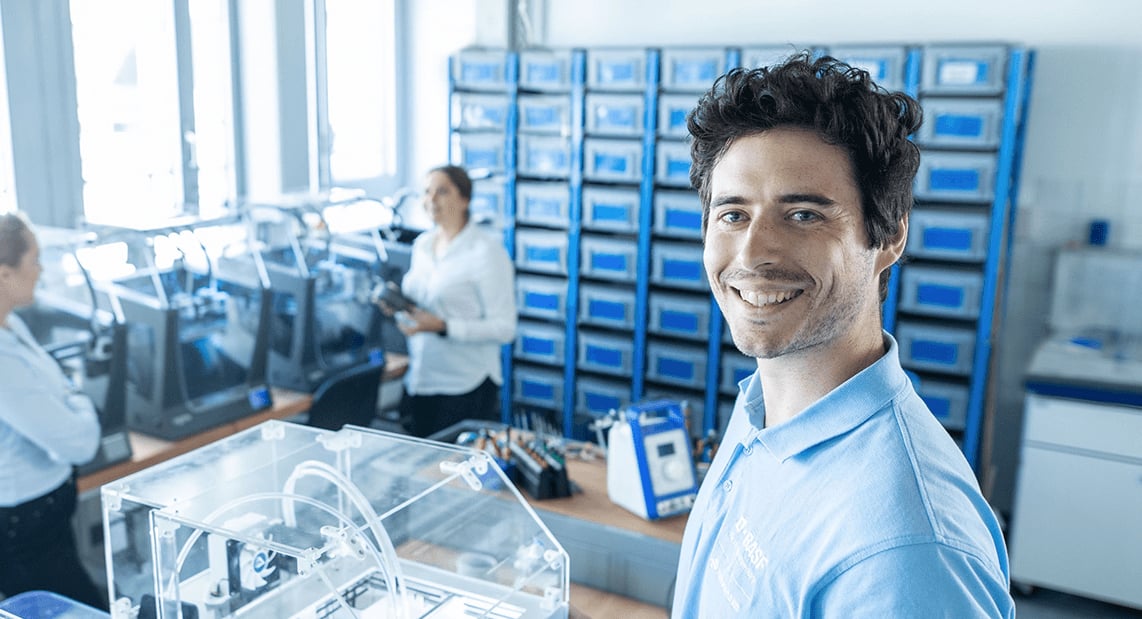
The Forward AM Innovation Award 2022 is now taking submissions from startups using additive manufacturing in product development, whether in the prototyping or final production phase. The competition, now in its second year, promises to connect start-ups with leading investors and industry experts, provide a €50,000 grand prize and €15,000 for best sustainable 3D printing application, along with exposure and an opportunity to pitch in front of a “curated audience of renowned industry leaders and investors”.
The competition aims to showcase entrepreneurs who are leveraging 3D printing in an innovative, sustainable, and scalable application. To be eligible to apply, your start-up should be less than five years old and employ fewer than 50 people. Start-ups that develop 3D printers, software, or materials are not eligible.
The deadline to apply is July 17, 2022. Forward AM is a subsidiary of chemical giant BASF.
3D Printing Industry News - Week 19, 2022
Farsoon’s New Metal 3D Printer Doesn’t Skimp on Features

Farsoon, the large Chinese 3D printer manufacturer, launched its new FS200M×2 platform for early adopters this week, expanding its portfolio of medium-sized metal laser powder bed fusion 3D printers. The FS200M×2 has a 425 x 230 x 300 mm build volume and a dual 500-watt laser configuration.
Farsoon says its advanced dual-laser scanning calibration algorithms sets it apart from other metal LPBF machines because the technology distributes each laser’s path for optimized build efficiency and speed, and features a “softened” laser overlap area for more uniform part properties. The FS200M×2 can also integrate multiple scanning strategies of different layer thicknesses in a single build according to the application’s needs.
The FS200M×2 is an open platform printer offering engineers a high degree of control to tailor the print parameters.
Other features that ensure uniform part properties throughout the build platform include the printers unique re-coater blade design, an integrated two-stage filter module, and an optimized gas flow layout.
As part of its quality control package, the FS200M×2 is equipped with in-chamber cameras which are used to monitor and record each layer. Besides logging the layer-to-layer data, the cameras also enable Farsoon’s real-time recoat monitoring feature, which records and analyzes each recoat layer in real-time. If a short feed or build error is detected, the software will automatically recoat or pause the build.
The FS200M×2 has a long list of ease-of-use features, no doubt developed from customer feedback, such as the top-feed powder system with sensors that alert you to refill once the powder level runs without disturbing the build process. There’s also the compact machine design consideration. The machine’s footprint is only 3.48 square meters with operational access from only front and right, and the build platform resides at a convenient hight for build plate install and removal.
Farsoon hasn’t released the price yet, but based on its other metal LPBF printers, this one, too, should be in the over-$500,000 range.
Ulti-Bot? Looking Forward to the Offspring of the Ultimaker, MakerBot Merger
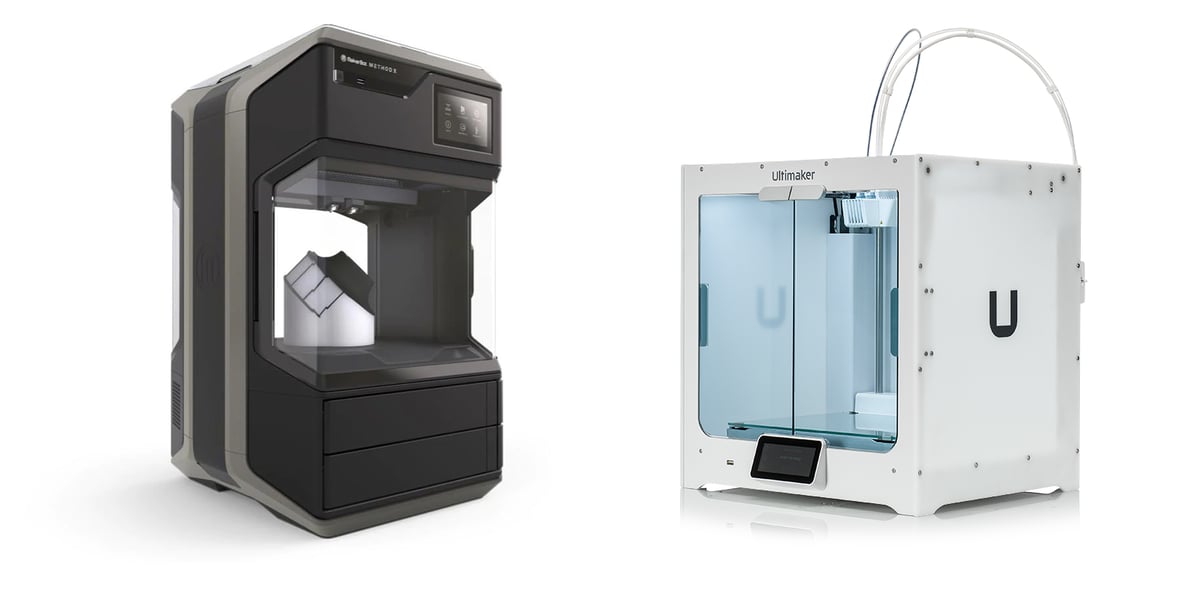
Two of the top brands in professional desktop 3D printers, Ultimaker and Makerbot, announced their planned merger yesterday with a new company name and branding to be revealed when the deal closes later this year.
Both Jürgen von Hollen, Ultimaker CEO, and Nadav Goshen, MakerBot CEO, said the merger represents an opportunity to change the way “that 3D printing works in the world.” The new company will focus on customer-centered hardware and software promoting ease of use and affordability. The target market is what they’re calling “light industrial,” which for now is anything from an architecture firm to a machine shop.
Despite similarities in customer base and technology, Ultimaker very seldom competes with MakerBot, Von Hollen said at yesterday’s press conference, emphasizing that Ultimaker and MakerBot complement each other and face the same challenges.
Don’t expect to see a marriage of actual printer technology. The current product portfolio will remain but expand, the two CEOs said.
I asked Von Hollen and Goshen what they always coveted about the other’s business. Von Hollen said he’s impressed by MakerBot’s close connection to the user and ability to understand their needs, plus there’s Thingiverse model repository. Goshen said Ultimaker has great application engineering along with, of course, Cura slicing software.
One problem in the market the two CEOs hope to solve as co-CEOs of the new company is the confusion people have about which 3D printer is best for their application. Von Hollen said the new company will be very clear on addressing that confusion, hinting that MakerBot and Ultimaker technology will target different segments of the market.
MakerBot, which is currently part of 3D printer giant Stratasys will be spun out and the merged entity will be owned by investors NPM Capital and Stratasys. Company owners plan a $62.4 million investment to accelerate the development of new hardware and software solutions.
Lead image source: MakerBot Method X at Wiesmann 1893 (Source: MakerBot)
License: The text of "3D Printing Industry News Digest" by All3DP Pro is licensed under a Creative Commons Attribution 4.0 International License.














